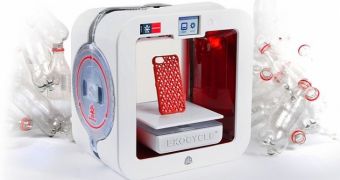Most 3D printers used plastic, which kind of kicked up dust in the eyes of a world that had begun to start dealing with the pollution issue. Given that, beverage makers Coca-Cola and will.i.am have decided to back the Ekocycle Cube from 3D Systems.
Ekocycle Cube, based on the Cube 3, is a 3D printer that creates objects from filament made of recycled plastic. Exclusively.
You might think that you can use any filament spool on it, that you can do what any other 3D printer will allow you to do, but that's not the case.
You see, instead of a spool, the filament comes in cartridges, so you really will have to order the things specifically from 3D Systems.
Each cartridge contains 25% post-consumer PET plastic bottles. So we suppose it's not exclusively recycled plastic, but still a lot better than any other filament in terms of environment friendliness.
That puts the Ekocycle Cube squarely at the head of the 3D systems industry when it comes to green computing and manufacturing. A figurehead if you will.
It kind of makes us glad to see that the product actually looks good, with a high-tech, futuristic design involving a closed-off build chamber and straightforward controls. It's also completely white.
Spec-wise, the Ekocycle Cube 3D printer has a resolution of 70 microns (100 microns is considered good, and the smaller the better), and a top printed item height of 6 inches / 152 mm.
The print speed will vary based on the complexity of the design, and how large you want it to be. Don't expect any miracles though. You can't order a 3D printer to get a move on any more than you can force people to take care when recycling waste if they don't want to.
Sure, if we're right, then 3D printing speed will match the speed of paper printing in five years or so. At the present time, however, it still takes hours or days for a single item to be created this way.
The Ekocycle Cube 3D printer will be released at some point later this year, for the price of $1,200 / €885 (or €1,200 if, yet again, exchange rates end up not mattering one whit). It's a reasonable price, though we're not sure if that will apply to the cartridges themselves as well.
Then again, regardless of how cheap it is, as you print more and more things, the filament has the tendency to pile up the cost until it exceeds that of the printer itself anyway. It only takes time.

 14 DAY TRIAL //
14 DAY TRIAL //